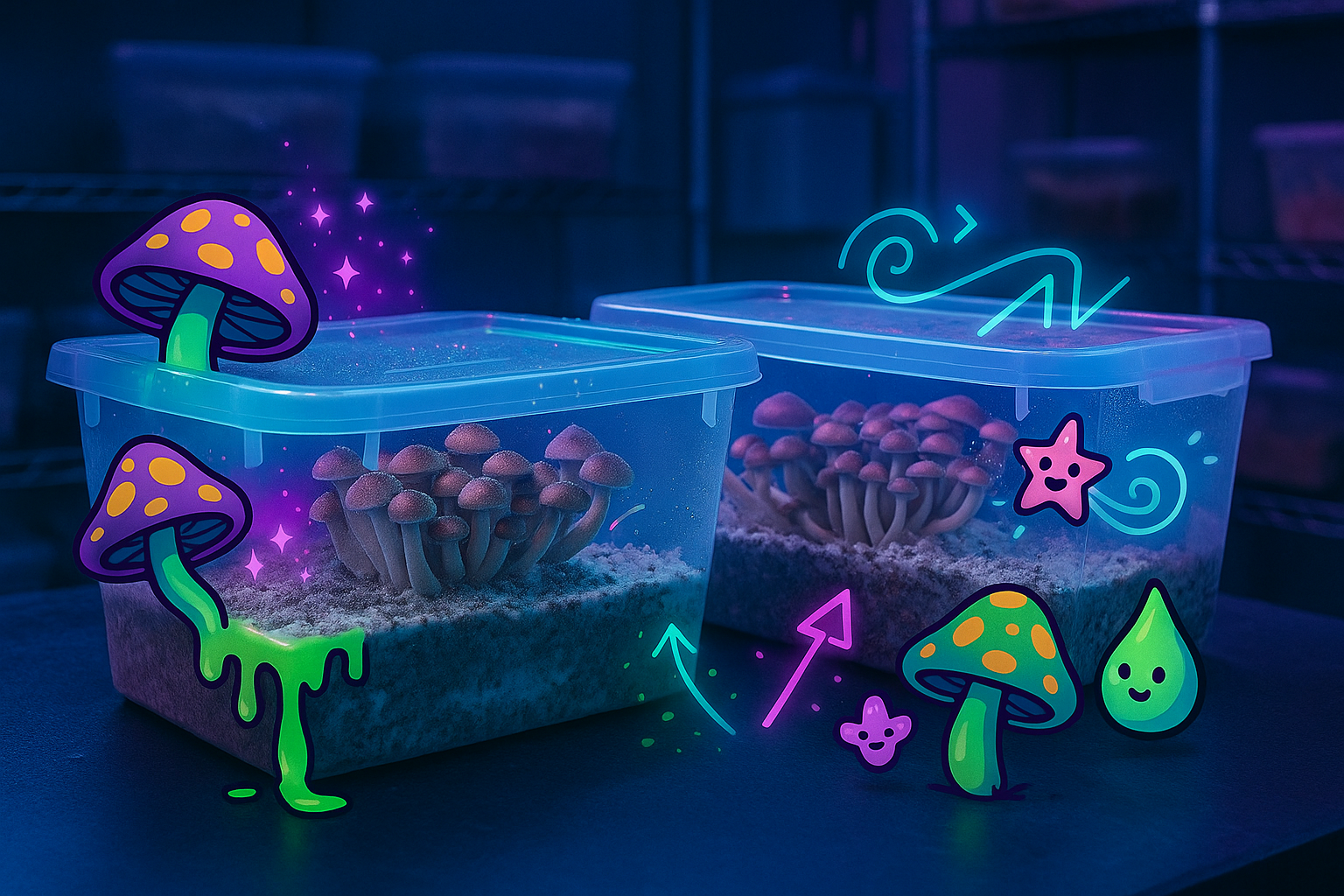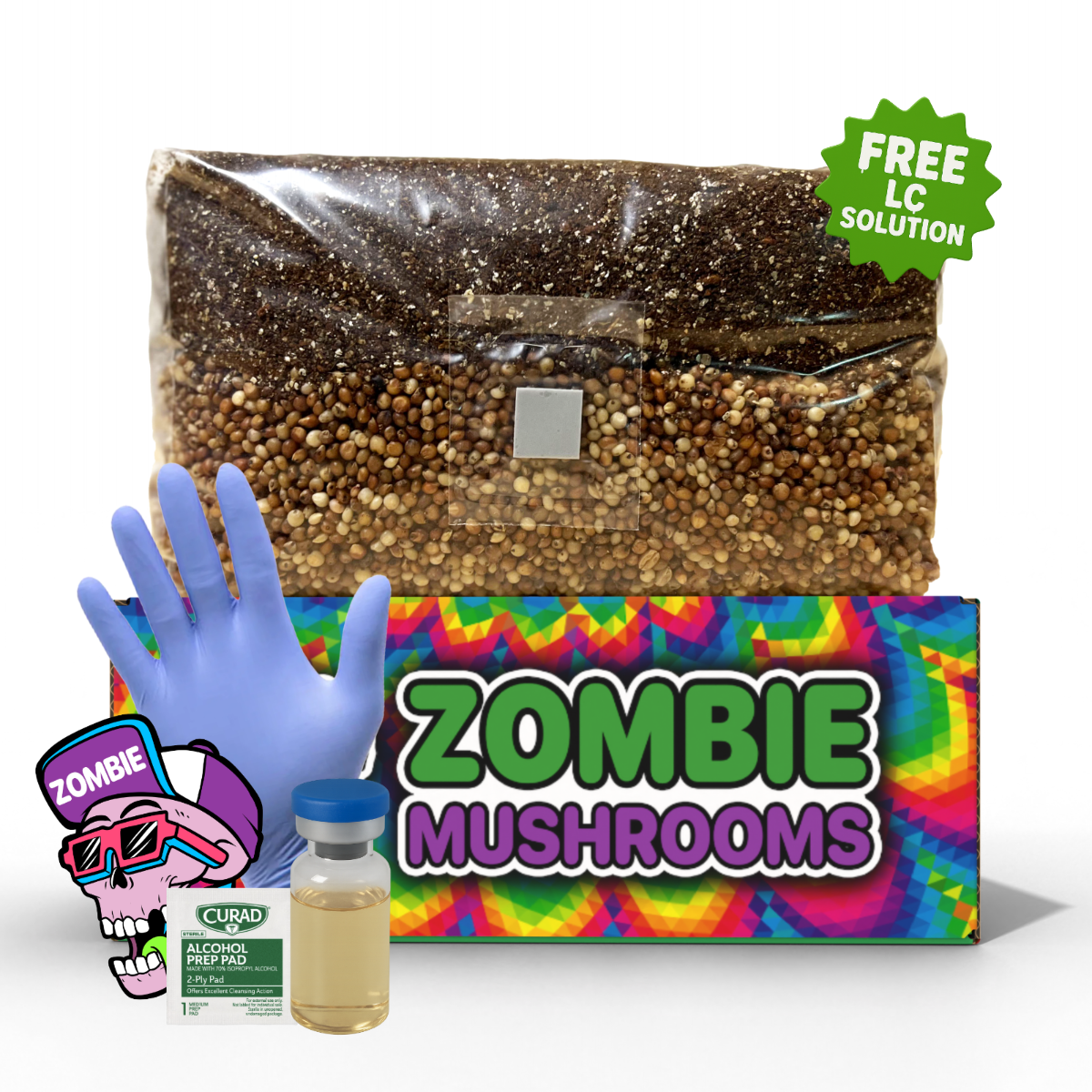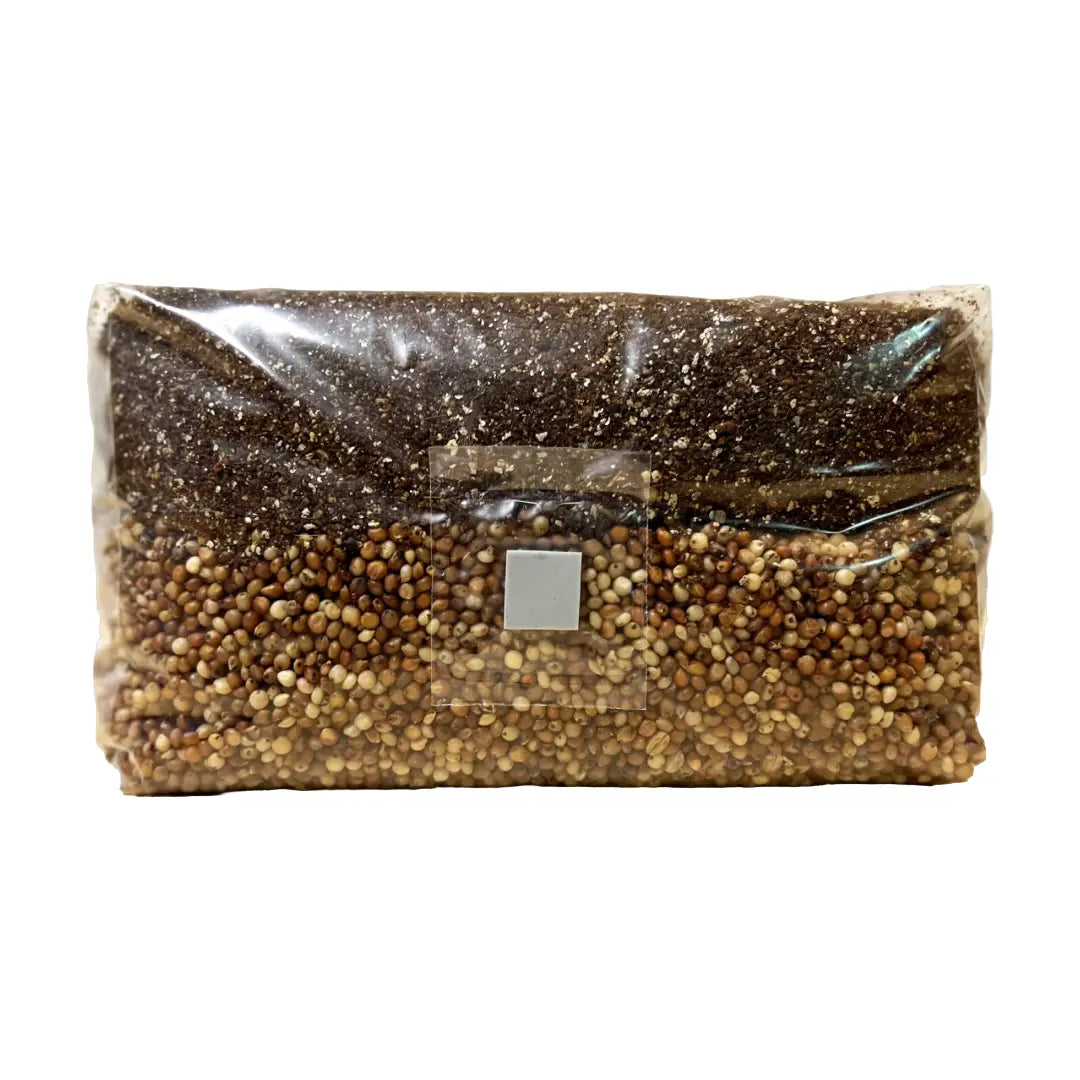⬇️ Prefer to listen instead? ⬇️

- 🍄 Shoebox Tek can yield 150–350g of fresh mushrooms per container, making it efficient for small-scale growers.
- 🧪 Colonization typically completes in 10–14 days under optimal conditions around 70–75°F.
- 🏙️ Urban growers benefit from Shoebox Tek’s minimal space and equipment requirements.
- ⚠️ Over-saturation of substrate drastically increases risk of contamination.
- 📈 Shoebox Tek offers up to 10x return compared to store-bought mushrooms at a fraction of the cost.

Quick & Easy Mushroom Growing: The Shoebox Tek Technique
Many people are growing mushrooms at home. It's a way to grow your own food or wellness items. You don't need a fancy lab or professional setup to start. Shoebox Tek is an easy, small growing method. It works for beginners, people with little space, and those who like to do things themselves. This guide covers everything about growing shoebox tek mushrooms. It starts with preparation and goes through harvesting, choosing species, and making your setup bigger. When you’re ready to take the same simple approach on a larger scale, our monotubs offer the perfect upgrade for bigger harvests with the same reliable results.
What Is Shoebox Tek?
Shoebox Tek is a small, effective way to grow mushrooms. It uses a shoebox-sized plastic container. The word “Tek” means “technique.” It comes from the mushroom growing community. In this group, detailed steps for growing mushrooms are often called "teks."
This method comes from Monotub Tek. Monotub Tek is a popular and effective setup for growing more mushrooms indoors. Shoebox Tek uses the same main ideas as Monotub. This includes grain spawn, bulk substrate, and high humidity. But it puts them into a smaller container for little grows.
Most Shoebox Tek setups use 6-quart clear plastic bins. You can find these easily online or in stores. They hold the substrate and keep in humidity for fruiting.

Why Choose Shoebox Tek?
Many people try mushroom growing because they are curious, want to be self-sufficient, or want clean, organic food. Shoebox Tek has good benefits for all of them:
✅ Low Startup Cost
You can start with things you already have at home. Or, you can spend as little as $15–$30 for everything you need to start your first successful grow.
💡 Minimal Space Requirement
One 6-quart tub grows well in small indoor spaces. Many growers put several shoeboxes on one shelf. They can also stack them in a small greenhouse. This means you don't need a special grow room.
🧼 Contamination Control
Smaller, separate grows help lower the chance of contamination. If one shoebox gets infected, it won't ruin your whole setup. This is a big help, especially for new growers.
🧪 Great Learning Tool
This method teaches main ideas in mushroom growing. You learn about preparing substrate, watching colonization, fruiting conditions, and clean methods. This is all key knowledge if you want to make your grows bigger.
Shoebox Tek also changes easily. For example, you can change airflow with micropore tape. You can also make specific warm, wet conditions with a simple plastic lid. And you can try harvesting many times for more yields.

What You Need to Get Started – Supplies & Setup
Setting up Shoebox Tek is very simple. Here is a list of what you need for your first successful grow:
🍄 Basic Equipment List
- Colonized Grain Spawn: Usually comes pre-sterilized in bags or jars.
- Bulk Substrate: Typically coco coir and vermiculite; some include gypsum for added minerals.
- Plastic Shoebox Container (6-quart): Preferably clear with a loosely fitting lid.
- Container Liner: A black plastic trash bag or similar material to prevent side pinning.
- Spray Bottle of Distilled Water: Maintains ideal humidity.
- Micropore Tape or Polyfill (optional): For personalized air exchange needs.
- 70% Isopropyl Alcohol: Critical for sterilization.
- Gloves and Facemask: Essential for reducing contamination risk.
🧪 Fast Track Option with Grow Kits
For those just learning how to grow mushrooms, and who don't want to get deep into substrate science and cleaning, brands like Zombie Mushrooms sell ready-to-use grow kits. These often come with pre-colonized spawn and pasteurized substrate. This lets you go right to mixing.
Step-by-Step Guide to Shoebox Tek
Here is a more detailed explanation of each step. It shows how to get your mushrooms from spore to harvest:
1. Pasteurize the Bulk Substrate
Use coco coir and vermiculite. Wet your substrate until it is at “field capacity.” This means it's wet but not dripping. Pasteurize the mix by keeping it at 160–180°F (71–82°C) for one hour. This kills bad germs but keeps good ones.
2. Mix with Spawn
Mix your colonized grain with the cooled, pasteurized substrate. Do this in a clean area or a Still Air Box (SAB). A 1:1 or 1:2 ratio (spawn:substrate) usually works best. This helps colonization happen fast and makes it harder for contamination to start.
3. Fill Your Shoebox
Put the mix evenly into your plastic container. Make it 2.5–4 inches deep. Gently flatten the top so it colonizes evenly.
4. Seal for Colonization
Close the lid tightly. Or, seal any air holes with micropore tape. Store the shoebox in a warm, dark place around 70–75°F. Colonization takes 10–14 days. This depends on the species and conditions.
5. Initiate Fruiting Conditions
When the substrate is fully white with mycelium (colonized), give it fresh air and light. Take off the lid, or make air holes propped open with tape. Put the shoebox in a spot with indirect light. This copies natural day and night.
6. Mist & Monitor
Mist the substrate when it looks dry or shrinks. The container should stay very humid. But controlling the small humid areas inside is key. Make sure you see water drops, but not puddles.
7. Pinning Begins
Within 2–5 days of fruiting, you should see “pins” form. These are tiny mushroom heads. They will grow fast into full mushrooms in another 3–7 days.
8. Harvest
Harvest just before the mushroom caps spread flat or turn upside down. Just twist and pull gently at the base. Or, cut cleanly with a sterile blade. This keeps the substrate in good shape for more flushes.

Ideal Mushroom Species for Shoebox Tek
If you're wondering how to pick the right mushroom for your first grow, here are the best ones for Shoebox Tek:
🍄 Psilocybe cubensis
This is one of the most popular species to grow at home, especially among people who study fungi. It colonizes fast, fruits well, and does okay in normal growing conditions.
🍄 Oyster Mushrooms (Pleurotus spp.)
Oysters are great for beginners. They grow fast and easily. They react fast to fruiting conditions. And many types fruit well in simple humid setups.
🍄 Lion’s Mane (Hericium erinaceus)
Lion's Mane is known for its health benefits and unique look. It can also work with shoebox tech if you give it more air.
Start with types that are easy to grow and grow well. Once you feel sure of yourself, try more specialized species. This includes wood lovers, shiitake, or even medicinal polypores. You would use changed setups for these.
Pros of Using Shoebox Tek
Let's look at the main reasons this method works so well and is easy for beginners in mushroom growing:
- It's self-contained and flexible: This makes it easy to keep contaminations, experiments, and different strains separate.
- It offers an easy way to learn: You can try different things without risking your whole crop.
- It's quiet and can be hidden: It holds its own humidity and doesn't need any electric equipment.
- Reusability: You can reuse containers after cleaning them. And you can get many flushes from the same substrate.
Common Mistakes and How to Avoid Them
Avoid these common mistakes that many new mushroom growers make:
🚫 Overhydration
A soggy substrate with brown gunk or sour smells means bacterial contamination. Always squeeze water from your bulk substrate when you wet it.
🧽 Poor Sterilization
Clean methods are a must. Always use gloves, clean your bins well, and work in a clean air space when mixing spawn and substrate.
⚖️ Imbalanced Substrate Ratio
Too much substrate and not enough spawn means slow colonization and brings in contaminants. Stick to a 1:1 or 1:2 spawn-to-substrate ratio.
🌡️ Incorrect Temperature or Light
Do not put your shoebox in direct sunlight or cold garages. Keep the room at a steady, normal temperature to make sure it works.
Harvesting and Yields
One shoebox should yield 150–350 grams of fresh mushrooms on average. This depends on the strain, air flow, substrate, and pinning conditions (Rogers, 2019). Fresh mushrooms are about 90% water. So, after drying, you can expect 15–35 grams per flush.
And you can expect 2 to 3 flushes per shoebox. This happens with the right wetting cycles, also called rehydration or dunking.
Shoebox Tek vs. Other Mushroom Growing Methods
Compare this method against other popular mushroom cultivation techniques:
| Feature | Shoebox Tek | PF Tek (Cake Method) | Monotub |
|---|---|---|---|
| Footprint | Small | Very small | Large |
| Ease of Setup | Moderate | Beginner-friendly | Moderate-Advanced |
| Yield | Medium (150–350g) | Low | High (500g+) |
| Contamination Risk | Low | Low | High |
| Cost | $15–30 | $10–20 | $50–100+ |

Cleanliness Is Key: Sterile Setup & Air Quality
Paying close attention to cleanliness really helps. Follow these steps:
- Always work in an area you've cleaned beforehand. Or, use a Still Air Box.
- Wear nitrile or latex gloves. Clean your hands and tools before you touch anything.
- Only open your containers when you need to. Mist without moving the surface too much.
Paul Stamets is a well-known mycologist and author. He stresses that steady humidity and temperatures between 70–75°F are important for good growing (Stamets, 2000). Checking daily helps a lot. It lets you spot contamination early and keep your mycelium healthy and strong.
When and Why to Scale Up
Many growers love growing mushrooms. They want more yields, more types, and more chances to try new things. Here's how to know it's time to grow past Shoebox Tek:
- You have gotten 2–3 good harvests often.
- You want to supply others, sell, or try new nutrition or supplement mixes.
- Your current small grows don't make enough.
Move up to Monotubs or bigger automated systems. Some growers add new parts to greenhouses. Or, they make their own humidity and air control systems from cheap hobby parts.
Real ROI (Return on Investment): Is It Worth Doing Shoebox Tek?
Let's look at some quick numbers based on average results:
- Setup cost: $20–30
- Yield: 150–350g (fresh)
- Dried Yield: ~15–35g
- Market Value: Dried mushrooms can sell for $5–$20 per gram depending on the species and legality
Store-bought exotic or medicinal mushrooms can be costly. Shoebox Tek gives you a good return on your money and is satisfying. If you want clean, organic, very local produce or microdosing supplements, you save even more.
Final Thoughts: Why Shoebox Tek Is a Smart Start
Shoebox Tek is a very simple and effective way to start growing mushrooms. It is great for anyone with little space, time, or money. It gives real results without needing advanced gear or complex steps.
Over time, you will learn about temperature control, colonization times, fruiting methods, and different strains. This method gives you a base you can use to grow from. This is true whether you are interested in cooking mushrooms, medicinal fungi, or studying fungi.
If you are ready to start this rewarding hobby, Zombie Mushrooms has ready-to-go supplies and guides for beginners. These help make your first grow a success.
Citations
Rogers, P. (2019). Home Mushroom Cultivation: A Beginner’s Guide to Shoebox and Monotub Growing Techniques. MycoHouse Publications.
Stamets, P. (2000). Growing Gourmet and Medicinal Mushrooms. Ten Speed Press.
Seliškar, K., & Novak, T. (2021). Mushroom cultivation in urban spaces: prospects for sustainable food and biowaste valorization. Sustainability, 13(22), 12617. https://doi.org/10.3390/su132212617



